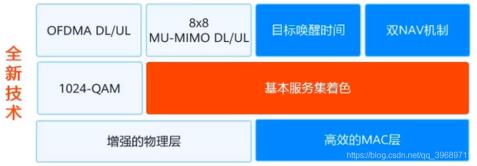First of all, let’s learn about IEEE 802.11ax. In the WiFi alliance, it is called WiFi 6, also known as a high-efficiency wireless local area network. It is a wireless local area network standard. 11ax supports 2.4GHz and 5GHz bands, and can be backward compatible with commonly used protocols in the 802.11a/b/g/n/ac market.
As shown in the figure below, the transmission rate is compared horizontally with that of 802.11n and 802.11ac:

How is WiFi 6 built to achieve such a fast speed?
WiFi 6 improves the working mode of the Wi-Fi network by enhancing coverage to achieve better consistency and reducing air interface media congestion so that users can most intuitively feel the linear increase in network speed. The more excellent point is that it can provide more users with consistent and reliable data throughput at the same time in a dense user environment, allowing them to achieve high-speed use of multiple users at the same time. The goal is to increase the average throughput of users by at least four times. In other words, a Wi-Fi network based on 802.11ax has a capacity and efficiency that has never been seen before.
In terms of bandwidth, 802.11ax adopts many of the technologies of 802.11ac. In terms of technology, it changes the way OFDMA modulation and multiplexing work, makes the subcarrier spacing narrower, uses 1024-QAM modulation mode and adds uplink MU-MIMO technology. This makes the theoretical speed of WiFi 6 AP break through 10Gbps and improves throughput and quality of service in high-density situations.
The figure shows the structure of 802.11ax:

The above is the knowledge explanation of the IEEE 802ax standard (also known as WiFi 6) brought to you by Shenzhen HDV Phoelectron Technology Co., Ltd. hope this article can help you to increase your knowledge. Besides this article if you’re looking for a good optical fiber communication equipment manufacturer company you may consider about us.
The communication products produced by the company cover:
Module: optical fiber modules, Ethernet modules, optical fiber transceiver modules, optical fiber access modules, SSFP optical modules, and SFP optical fibers, etc.
ONU category: EPON ONU, AC ONU, optical fiber ONU, CATV ONU, GPON ONU, XPON ONU, etc.
OLT class: OLT switch, GPON OLT, EPON OLT, communication OLT, etc.
The above products can support different network scenarios. For the above products, a professional and powerful R & D team is paired to provide technical support for customers, and a thoughtful and professional business team can provide high-quality services for customers’ early consultation and later work.





